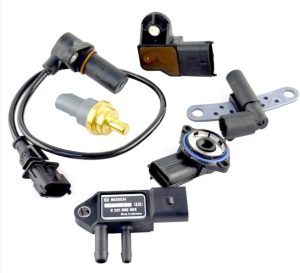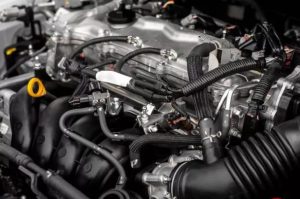Modern vehicles are more advanced than ever, and much of that sophistication comes from the network of sensors working inside your engine. These sensors constantly monitor parameters like air flow, temperature, pressure, and emissions, providing essential data to the engine control unit (ECU). The ECU then uses this data to optimize performance, fuel efficiency, and emissions — ensuring your car runs smoothly and reliably.
In this guide, we’ll cover the most important engine sensors, how they work, common symptoms of failure, and why maintaining them is crucial for vehicle performance.
What Are Engine Sensors and Why Are They Important?

Engine sensors are electronic devices that collect real-time data from various components and systems within the engine. This data helps the ECU adjust ignition timing, fuel injection, air-fuel ratio, and other critical parameters. Without functioning sensors, the engine cannot operate efficiently — and in some cases, may not run at all.
Main functions of engine sensors:
-
Optimize fuel economy and power output
-
Reduce emissions and meet environmental standards
-
Protect engine components from damage
-
Ensure safe and reliable engine operation
Key Engine Sensors and Their Functions
Here’s a detailed breakdown of the most essential sensors found in modern engines:
| Sensor Name | Function | Common Symptoms of Failure | Location |
|---|---|---|---|
| Mass Air Flow (MAF) Sensor | Measures the amount of air entering the engine for proper fuel mixture. | Poor acceleration, rough idling, reduced fuel efficiency. | Air intake system |
| Oxygen (O2) Sensor | Monitors oxygen levels in exhaust gases to adjust air-fuel ratio. | Increased emissions, check engine light, poor mileage. | Exhaust manifold / downpipe |
| Manifold Absolute Pressure (MAP) Sensor | Measures air pressure in the intake manifold to help calculate air density. | Hard starting, engine stalling, reduced power. | Intake manifold |
| Throttle Position Sensor (TPS) | Monitors throttle plate position to regulate fuel delivery. | Hesitation, stalling, erratic acceleration. | Throttle body |
| Coolant Temperature Sensor (CTS) | Monitors engine coolant temperature to regulate fuel mixture and fan operation. | Overheating, poor fuel economy, engine misfire. | Near thermostat housing |
| Crankshaft Position Sensor (CKP) | Tracks crankshaft position and speed for ignition and fuel timing. | Engine stalling, no-start condition, misfiring. | Engine block near crankshaft |
| Camshaft Position Sensor (CMP) | Monitors camshaft position to optimize fuel injection timing. | Hard starting, poor performance, increased fuel use. | Cylinder head / timing cover |
| Knock Sensor | Detects engine knocking (pre-detonation) and signals ECU to adjust timing. | Pinging noise, reduced power, check engine light. | Engine block |
| Exhaust Gas Recirculation (EGR) Sensor | Monitors EGR valve operation to reduce emissions. | Rough idle, failed emissions test, engine surging. | Intake manifold / near EGR valve |
| Intake Air Temperature (IAT) Sensor | Measures air temperature entering the engine to adjust fuel injection. | Poor cold starts, reduced power, high emissions. | Air intake duct |
Most Common Engine Sensors Explained
1. Mass Air Flow (MAF) Sensor
The MAF sensor is one of the most critical components in a fuel-injected engine. It measures the volume of air entering the intake and helps the ECU calculate how much fuel to inject.
Tip: A dirty MAF sensor is a common cause of poor performance and can often be cleaned rather than replaced.
2. Oxygen (O2) Sensor
Located in the exhaust system, this sensor measures the oxygen level in the exhaust gases. The ECU uses this data to adjust the air-fuel ratio for optimal combustion.
Tip: Most vehicles have at least two O2 sensors — one before and one after the catalytic converter.
3. Coolant Temperature Sensor (CTS)
This sensor informs the ECU about the engine’s temperature, ensuring that the correct amount of fuel is used during cold starts and normal operation.
Tip: A faulty CTS can cause incorrect fuel delivery, leading to rich or lean mixtures.
4. Crankshaft and Camshaft Position Sensors
These sensors work together to synchronize the engine’s timing. The crankshaft sensor monitors engine speed and position, while the camshaft sensor helps determine when to inject fuel and fire spark plugs.
Tip: If your car suddenly stalls or fails to start, these sensors are often the cause.
5. Knock Sensor
Detonation or “knock” can severely damage an engine. The knock sensor detects these vibrations and signals the ECU to adjust ignition timing, protecting your engine from damage.
Signs of Failing Engine Sensors
Recognizing sensor issues early can prevent expensive repairs. Here are the most common warning signs:
-
Check Engine Light: Often the first sign of a failing sensor.
-
Rough Idle or Stalling: May indicate issues with MAF, TPS, or MAP sensors.
-
Poor Fuel Efficiency: Faulty oxygen or temperature sensors can cause inefficient fuel combustion.
-
Hard Starting or No Start: Often caused by crankshaft or camshaft sensor failure.
-
Reduced Power or Hesitation: A sign of incorrect air-fuel mixture due to sensor errors.
How to Maintain and Replace Engine Sensors
While sensors are generally reliable, they do require occasional maintenance or replacement. Here are some tips:
Maintenance Tips:
-
Clean MAF and IAT sensors every 20,000–30,000 km.
-
Check connectors for corrosion or loose connections.
-
Use quality fuel and oil to prevent contamination of sensors.
Replacement Guide:
-
Disconnect the battery before working on sensors.
-
Locate the sensor using a vehicle repair manual.
-
Carefully unplug connectors and remove the sensor.
-
Install the new sensor and reconnect everything.
-
Clear any stored error codes with a diagnostic tool.
Recommended Replacement: Choose Quality Sensors

Using high-quality replacement sensors ensures accuracy and longevity. Low-quality sensors may fail prematurely or give incorrect readings, leading to costly repairs.
Explore and buy Engine Sensors online to find reliable options tailored to your vehicle.
Conclusion
Engine sensors are the unsung heroes of modern vehicles. They constantly feed data to the ECU, ensuring your engine runs efficiently, safely, and with optimal performance. Whether it’s measuring air flow, temperature, or emissions, each sensor plays a vital role in keeping your vehicle in top condition.
Regular inspection, cleaning, and timely replacement of faulty sensors will save you money, improve fuel economy, and extend your engine’s lifespan. By understanding these components, you can confidently maintain and troubleshoot your car’s engine — ensuring it performs at its best for years to come.